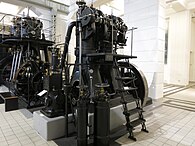
Air-blast injection is a historical direct injection system for Diesel engines. Unlike modern designs, air-blast injected Diesel engines do not have an injection pump. A simple low-pressure fuel-feed-pump is used instead to supply the injection nozzle with fuel. At injection, a blast of compressed air presses the fuel into the combustion chamber, hence the name air-blast injection. The compressed air comes from compressed-air tanks which feed the injection nozzle. A large crankshaft-driven compressor is used to re-fill these tanks; the size of the compressor and the low rotational frequency of the engine's crankshaft means that air-blast injected Diesel engines are huge in size and mass, this, combined with the problem that air-blast injection does not allow for quick load alteration[1] makes it only suitable for stationary applications and watercraft. Before the invention of precombustion chamber injection, air-blast injection was the only way a properly working internal air fuel mixture system could be built, required for a Diesel engine. During the 1920s,[2] air-blast injection was rendered obsolete by superior injection system designs that allowed much smaller but more powerful engines.[3] Rudolf Diesel was granted a patent on air-blast injection in November 1893 (DRP 82 168).[4]
- ^ Rüdiger Teichmann, Günter P. Merker (publisher): Grundlagen Verbrennungsmotoren : Funktionsweise, Simulation, Messtechnik , 7th issue, Springer, Wiesbaden, 2014, ISBN 978-3-658-03195-4, p. 381.
- ^ Rüdiger Teichmann, Günter P. Merker (publisher): Grundlagen Verbrennungsmotoren : Funktionsweise, Simulation, Messtechnik , 7th issue, Springer, Wiesbaden, 2014, ISBN 978-3-658-03195-4, p. 382.
- ^ Anton Pischinger, Otto Cordier: Gemischbildung und Verbrennung im Dieselmotor, Springer, Wien, 1939, ISBN 978-3-7091-9724-0, p. 1
- ^ Rudolf Diesel: Die Entstehung des Dieselmotors, Springer, Berlin 1913, ISBN 978-3-642-64940-0, p. 21



